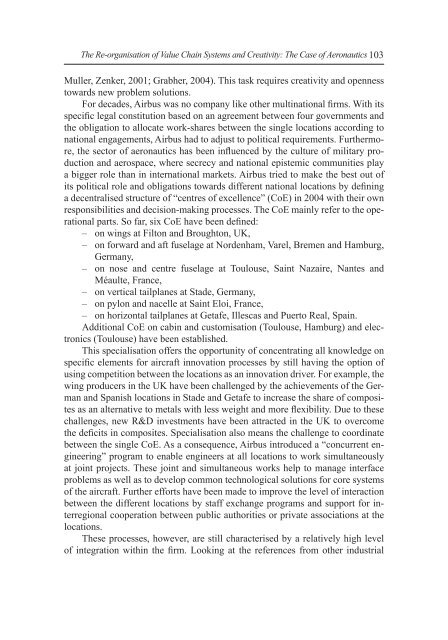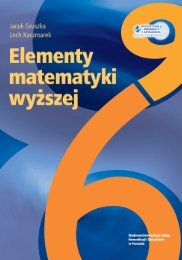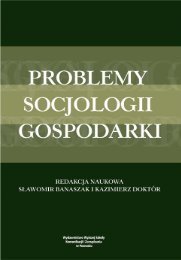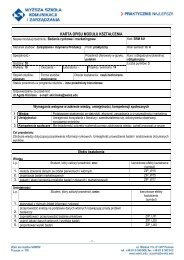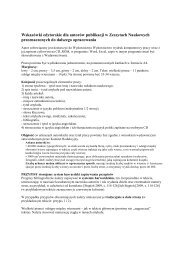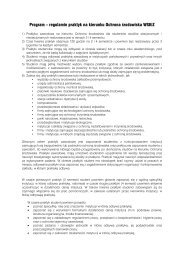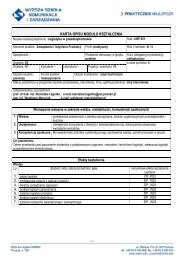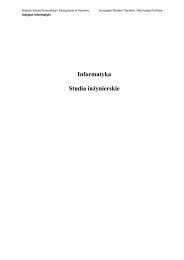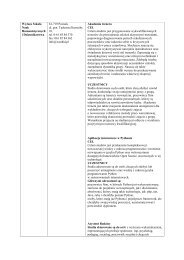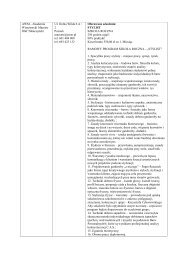- Page 2:
Socjologicznei psychologiczneproble
- Page 6 and 7:
Spis treściPrzedmowa..............
- Page 8 and 9:
Słowo wstępneOddajemy do rąk Czy
- Page 14:
Culture’s recent consequences 13b
- Page 17 and 18:
16Geert Hofstedetime scale. LTO cou
- Page 19 and 20:
18Geert HofstedeIt needs to be emph
- Page 21 and 22:
20Jan Sikora, Agnieszka Wartecka-Wa
- Page 23 and 24:
22Jan Sikora, Agnieszka Wartecka-Wa
- Page 25 and 26:
24Jan Sikora, Agnieszka Wartecka-Wa
- Page 27 and 28:
26Jan Sikora, Agnieszka Wartecka-Wa
- Page 29 and 30:
28Jan Sikora, Agnieszka Wartecka-Wa
- Page 31 and 32:
30Jan Sikora, Agnieszka Wartecka-Wa
- Page 33 and 34:
32Sylwester M. Kaniaorganizacyjne (
- Page 35 and 36:
34Sylwester M. Kaniawarunkiem jest
- Page 37 and 38:
36Sylwester M. Kaniadziałanie firm
- Page 39 and 40:
38Sylwester M. Kaniastatki pasażer
- Page 41 and 42:
40Sylwester M. Kaniapożądana ze w
- Page 43 and 44:
42Sylwester M. KaniaDokonując ocen
- Page 46 and 47:
Renata Krzykała-SchaeferMiędzykul
- Page 48 and 49:
Międzykulturowe dylematy zarządza
- Page 50 and 51:
Międzykulturowe dylematy zarządza
- Page 52 and 53:
Międzykulturowe dylematy zarządza
- Page 54: Międzykulturowe dylematy zarządza
- Page 57 and 58: 56Renata Krzykała-SchaeferRozwiąz
- Page 59 and 60: 58Renata Krzykała-Schaefermiędzyn
- Page 61 and 62: 60Renata Krzykała-SchaeferSchroede
- Page 63 and 64: 62Beata PawłowskaZawarte w artykul
- Page 65 and 66: 64Beata PawłowskaKwestia budząca
- Page 67 and 68: 66Beata Pawłowskarozpoczyna się
- Page 69 and 70: 68Beata Pawłowskao sobie, o naszyc
- Page 71 and 72: 70Beata PawłowskaRozmawiali o prac
- Page 73 and 74: 72Beata Pawłowskapojawiają się n
- Page 76 and 77: Sławomira Kamińska-Berezowska, Ja
- Page 78 and 79: Znaczenie symboli i rytuałów orga
- Page 80 and 81: Znaczenie symboli i rytuałów orga
- Page 82 and 83: Znaczenie symboli i rytuałów orga
- Page 84 and 85: Znaczenie symboli i rytuałów orga
- Page 86: Znaczenie symboli i rytuałów orga
- Page 89 and 90: 88Jacek Korskiwystępujących w spo
- Page 91 and 92: 90Jacek KorskiPoważny urazLekki ur
- Page 93 and 94: 92Jacek Korskiwpływ czynników zwi
- Page 95 and 96: 94Jacek KorskiBadania Katedry Zarz
- Page 97 and 98: 96Jacek KorskiMotyka J., Nowak K.,
- Page 99 and 100: 98Rüdiger Winkpart provides empiri
- Page 101 and 102: 100Rüdiger WinkOrganisational and
- Page 103: 102Rüdiger Wink-- the creation of
- Page 107 and 108: 106Rüdiger WinkIn the case of prem
- Page 109 and 110: 108Rüdiger Winkdifferent engineeri
- Page 111 and 112: 110Rüdiger WinkAdjustments in the
- Page 113 and 114: 112Rüdiger Winkhow to deal with ne
- Page 115 and 116: 114Rüdiger WinkOEM. The problems a
- Page 117 and 118: 116Rüdiger WinkOrlikowski W.J., 20
- Page 120 and 121: Kazimierz DoktórElity panowania i
- Page 122 and 123: Elity panowania i kierownicy zarzą
- Page 124 and 125: Elity panowania i kierownicy zarzą
- Page 126 and 127: Elity panowania i kierownicy zarzą
- Page 128: Elity panowania i kierownicy zarzą
- Page 131 and 132: 130Sławomir BanaszakMenedżerowie
- Page 133 and 134: 132Sławomir Banaszakczy też teren
- Page 135 and 136: 134Sławomir Banaszakiż dobrobyt t
- Page 137 and 138: 136Sławomir Banaszakzwolnienia, zm
- Page 139 and 140: 138Sławomir Banaszakkooperacji w z
- Page 142 and 143: Agnieszka KozakMenedżer nośnikiem
- Page 144 and 145: Menedżer nośnikiem wartości w or
- Page 146 and 147: Menedżer nośnikiem wartości w or
- Page 148 and 149: Menedżer nośnikiem wartości w or
- Page 150 and 151: PodsumowanieMenedżer nośnikiem wa
- Page 152 and 153: Ilona Świątek-Barylska, Bożena M
- Page 154 and 155:
Menedżer wobec zmiany miejsca prac
- Page 156 and 157:
Menedżer wobec zmiany miejsca prac
- Page 158 and 159:
Menedżer wobec zmiany miejsca prac
- Page 160 and 161:
Menedżer wobec zmiany miejsca prac
- Page 162 and 163:
Przemysław WechtaPrzedsiębiorca a
- Page 164 and 165:
Przedsiębiorca a menedżer 163znac
- Page 166 and 167:
Przedsiębiorca a menedżer 165Rynk
- Page 168:
Przedsiębiorca a menedżer 167Wnio
- Page 171 and 172:
170Mariola ŁagunaPozytywne przekon
- Page 173 and 174:
172Mariola Łagunaosoby zdolnej wym
- Page 175 and 176:
174Mariola Łagunaa zidentyfikowani
- Page 177 and 178:
176Mariola ŁagunaWyniki badańSpo
- Page 179 and 180:
178Mariola ŁagunaDyskusja wyników
- Page 181 and 182:
180Mariola ŁagunaŁaguna M., 2006c
- Page 184 and 185:
Jagoda JeziorPotencjał zawodowy pr
- Page 186 and 187:
Potencjał zawodowy przedsiębiorc
- Page 188 and 189:
Potencjał zawodowy przedsiębiorc
- Page 190 and 191:
Potencjał zawodowy przedsiębiorc
- Page 192 and 193:
Potencjał zawodowy przedsiębiorc
- Page 194 and 195:
Potencjał zawodowy przedsiębiorc
- Page 196 and 197:
Potencjał zawodowy przedsiębiorc
- Page 198 and 199:
Potencjał zawodowy przedsiębiorc
- Page 200:
Część IIIPartycypacja pracownicz
- Page 203 and 204:
202Andrzej Suwalskiw Stanach Zjedno
- Page 205 and 206:
204Andrzej Suwalskiprywatyzacja ka
- Page 207 and 208:
206Andrzej Suwalskiprzedsiębiorstw
- Page 209 and 210:
208Andrzej SuwalskiKrawczyk R., 199
- Page 211 and 212:
210Janina Stankiewicz, Marta Moczul
- Page 213 and 214:
212Janina Stankiewicz, Marta Moczul
- Page 215 and 216:
214Janina Stankiewicz, Marta Moczul
- Page 217 and 218:
216Janina Stankiewicz, Marta Moczul
- Page 219 and 220:
218Janina Stankiewicz, Marta Moczul
- Page 221 and 222:
220Janina Stankiewicz, Marta Moczul
- Page 224 and 225:
Grażyna BartkowiakPostrzeganie sys
- Page 226 and 227:
Postrzeganie systemów motywacyjnyc
- Page 228 and 229:
Postrzeganie systemów motywacyjnyc
- Page 230 and 231:
Postrzeganie systemów motywacyjnyc
- Page 232 and 233:
Elżbieta KowalczykPraca jako przed
- Page 234 and 235:
Praca jako przedmiot negocjacji we
- Page 236 and 237:
Praca jako przedmiot negocjacji we
- Page 238 and 239:
Praca jako przedmiot negocjacji we
- Page 240 and 241:
Praca jako przedmiot negocjacji we
- Page 242 and 243:
Praca jako przedmiot negocjacji we
- Page 244:
Praca jako przedmiot negocjacji we
- Page 248 and 249:
Henryk JanuszekOdpowiedzialność s
- Page 250 and 251:
Odpowiedzialność społeczna bizne
- Page 252 and 253:
Odpowiedzialność społeczna bizne
- Page 254 and 255:
Odpowiedzialność społeczna bizne
- Page 256 and 257:
Odpowiedzialność społeczna bizne
- Page 258 and 259:
Odpowiedzialność społeczna bizne
- Page 260 and 261:
Odpowiedzialność społeczna bizne
- Page 262:
Odpowiedzialność społeczna bizne
- Page 265 and 266:
264Małgorzata Suchacka, Marek S. S
- Page 267 and 268:
266Małgorzata Suchacka, Marek S. S
- Page 269 and 270:
268Małgorzata Suchacka, Marek S. S
- Page 271 and 272:
270Małgorzata Suchacka, Marek S. S
- Page 274 and 275:
Małgorzata Adamska-ChudzińskaPła
- Page 276 and 277:
Płaszczyzny zaangażowania społec
- Page 278 and 279:
Płaszczyzny zaangażowania społec
- Page 280 and 281:
Barbara FryzełZarządzanie społec
- Page 282 and 283:
Zarządzanie społeczną akceptacj
- Page 284 and 285:
Zarządzanie społeczną akceptacj
- Page 286 and 287:
Zarządzanie społeczną akceptacj
- Page 288 and 289:
Zarządzanie społeczną akceptacj
- Page 290 and 291:
Zarządzanie społeczną akceptacj
- Page 292 and 293:
Sebastian SkolikSpołeczne problemy
- Page 294 and 295:
Społeczne problemy organizacji pra
- Page 296 and 297:
Społeczne problemy organizacji pra
- Page 298 and 299:
Społeczne problemy organizacji pra
- Page 300 and 301:
Społeczne problemy organizacji pra
- Page 302 and 303:
Społeczne problemy organizacji pra
- Page 304 and 305:
Społeczne problemy organizacji pra
- Page 306:
Społeczne problemy organizacji pra
- Page 309 and 310:
308Arleta Olbrot-Brzezińskapublicz
- Page 311 and 312:
310Arleta Olbrot-Brzezińskapracy.
- Page 313 and 314:
312Arleta Olbrot-BrzezińskaCiekawy
- Page 315 and 316:
314Arleta Olbrot-Brzezińskawolonta
- Page 317 and 318:
316Arleta Olbrot-Brzezińskazweryfi
- Page 319 and 320:
318Arleta Olbrot-BrzezińskaWymiern
- Page 321 and 322:
320Arleta Olbrot-BrzezińskaJordan
- Page 323 and 324:
322Justyna Kliombka-Jarzynaalkoholu
- Page 325 and 326:
324Justyna Kliombka-Jarzynareedukac
- Page 327 and 328:
326Justyna Kliombka-Jarzynanauczeni
- Page 329 and 330:
328Justyna Kliombka-Jarzynawspieran
- Page 331 and 332:
330Justyna Kliombka-JarzynaKrajowy
- Page 334 and 335:
Jerzy OlszewskiKobiety na rynku pra
- Page 336 and 337:
Kobiety na rynku pracy 335ich stanu
- Page 338 and 339:
Kobiety na rynku pracy 337wizacji z
- Page 340 and 341:
Kobiety na rynku pracy 339W analizo
- Page 342 and 343:
Kobiety na rynku pracy 341na 100 m
- Page 344 and 345:
Kobiety na rynku pracy 343Tabela 1.
- Page 346 and 347:
Kobiety na rynku pracy 345Na podsta
- Page 348 and 349:
Kobiety na rynku pracy 347Emerytury
- Page 350 and 351:
Kobiety na rynku pracy 349które ni
- Page 352:
Kobiety na rynku pracy 351Kupidura
- Page 355 and 356:
354Zbigniew Galorb) grup osób (cz
- Page 357 and 358:
356Zbigniew GalorLumpenwłasność
- Page 359 and 360:
358Zbigniew Galorzarejestrowane na
- Page 361 and 362:
360Zbigniew GalorStosowanie nielega
- Page 363 and 364:
362Zbigniew Galorzłodziei-robotnik
- Page 366 and 367:
Joanna HałajStres organizacyjny a
- Page 368 and 369:
Stres organizacyjny a syndrom wypal
- Page 370 and 371:
Stres organizacyjny a syndrom wypal
- Page 372 and 373:
Stres organizacyjny a syndrom wypal
- Page 374 and 375:
Stres organizacyjny a syndrom wypal
- Page 376:
Stres organizacyjny a syndrom wypal
- Page 379 and 380:
378Katarzyna Durniatszwedzki badacz
- Page 381 and 382:
380Katarzyna Durniatsię pytanie o
- Page 383 and 384:
382Katarzyna DurniatZ pytań dodany
- Page 385 and 386:
384Katarzyna Durniatpowyżej 10 lat
- Page 387 and 388:
386Katarzyna Durniatpunkt wyjścia
- Page 389 and 390:
388Katarzyna Durniat--styl zoriento
- Page 391 and 392:
390Katarzyna DurniatPrzedstawiony w
- Page 393 and 394:
392Katarzyna DurniatZapf D., Knorz
- Page 395:
394Noty o AutorachDr Elżbieta Kowa


